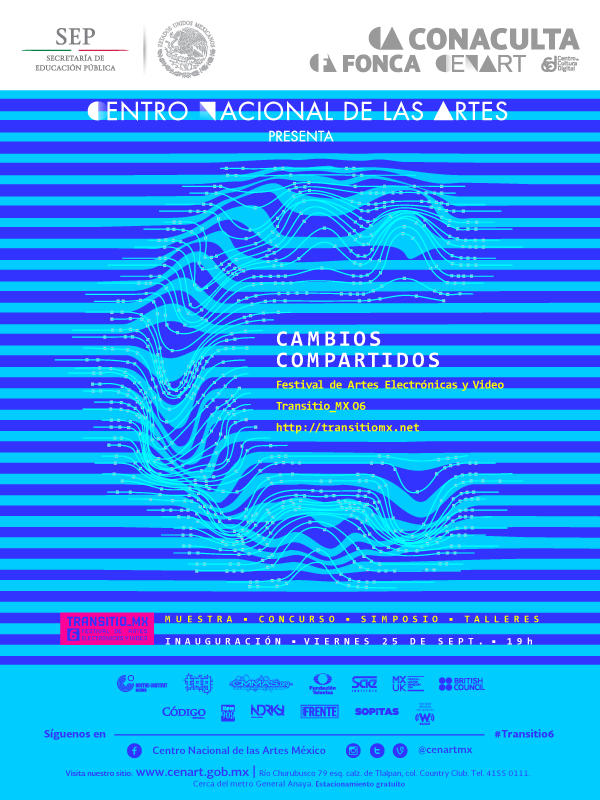Archive for the ‘Video Art’ Category
Transitio_MX 06 Cambios Compartidos Opens 9/25
This year’s installation of Mexico City’s Festival of Electronic Arts and Video Transitio_MX 06 is titled “Cambios Compartidos” (“Shared Changes”) and opens Friday September 25th and runs through October 4th at the National Center of the Arts. “a geography of being : una geografia de ser” will be on view and the game is available to play online.

audiophile at RedLine’s “Press Play” Exhibition

audiophile (2001) The software presents remixes of the sounds of the city, from Managua, Nicaragua to Mexico City to Manhattan
My 2001 net.art project “audiophile” is on view as part of the exhibition titled “Press Play” curated by Ruth Bruno and Cortney Lane Stell. “Press Play” is collaboratively produced between RedLine and Denver Arts & Venues. The exhibition is on view at McNichols Civic Center Building 144 West Colfax (corner of West Colfax and Bannock) from March 21st through June 28th.
Curators Stell and Bruno describe the conceptual premise of the “Press Play”:
“Rules of games, like those found in video games, imply ethical models or boundaries to be kept within in daily societal interactions and experiences. These parameters often structure our actions, perspectives, and worldviews. The artists in Press Play use these normative tools as structure, starting points, or forces to push against in their work. While some artworks explore conventional modes of structured play, other works use ruled play systems in order to subvert these conventional models of participation and competition.”
Participating Artists: Mark Amerika, Molly Bounds, Brody Condon, Milton Croissant III, Humberto Duque, Joseph Farbrook, Miltos Manetas, Eva and Franco Mattes, Alex Myers, Chad Person, and Ricardo Miranda Zúñiga.
“Universal Pictures” Roundtable at the Jewish Museum

Still from Lucy Raven’s “Curtains” (2014)
Tonight (1/22/15) I attended the Jewish Museum’s “Universal Pictures: Considering Contemporary Video Practice” – a roundtable discussion with artists Joan Jonas, Ken Okiishi, Lucy Raven and Jennifer West.
I was 30 minutes late and unfortunately missed Joan Jonas’s presentation.
I walked in at the end of Lucy Raven’s talk as she introduced the excerpt from her film “Curtains” (50 minutes, 2014). Raven traveled around the world to capture various post-production studios where films are processed into stereoscopic 3D films. The snippet itself appeared terribly boring to have to watch, but the conceptual basis is striking. In considering the use of sound, Raven remarked how, the 3D processing flattens the film to a moving hologram, whereas sound when using surround sound is much more immersive and physical and 3 dimensional. There was little time for question and answer, however, I would have liked to have heard Raven’s thoughts regarding the temporal reality of a given digital technical labor. Today these post production studios are getting tax breaks in major cities. As the tech becomes less specialized the labor will move to cheaper markets rather than major cities, I wondered how quickly these studios would dissolve. I would have liked to have heard her reflections regarding digital labor after having visited all these post production studios throughout the globe.
To Ken Okiishi, I have one suggestion – don’t put video in a PowerPoint presentation – doing so will keep your computer from crashing. The interactive paint ball installation was cool, but trite. And the painted screens seemed to be too much of a shtick, not very interesting as objects though momentarily engaging. I did like the parallel between these art objects and our use of smart phones with traces of greasy finger marks…
Jennifer West presented fascinating material, including a satirical 18th century illustration of people’s fascination with lenses. She discussed her practice of using recycled film, drawing from the magic lantern, interests in pre-cinema practices, the beauty of 70mm film. The use of flash light projections in her installations. And she ended with images or brainstorming around her ongoing project on film memory. Which lead me to consider what do I remember of a favorite film? The pieces that stand out? And to consider the psychological power of circulation & cinema upon a mass public.
The Jewish Museum should have allotted more time for this roundtable, I’m sure other people had questions, but they pressed how they had gone beyond the given time.